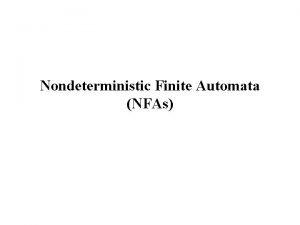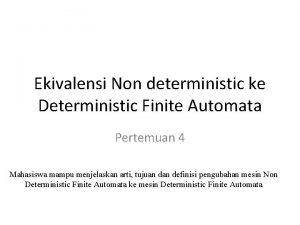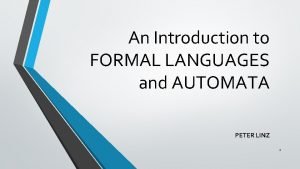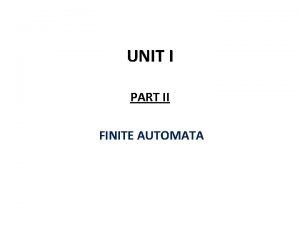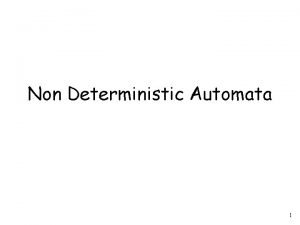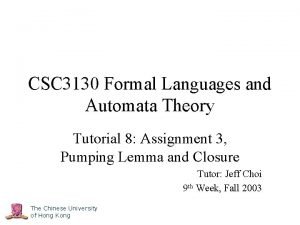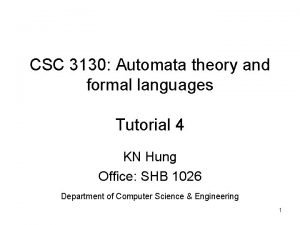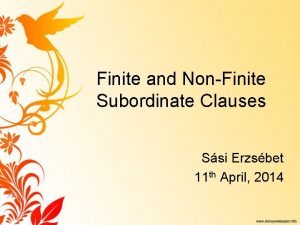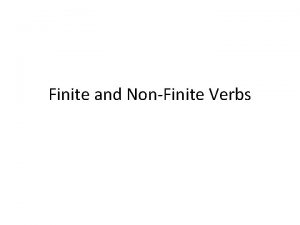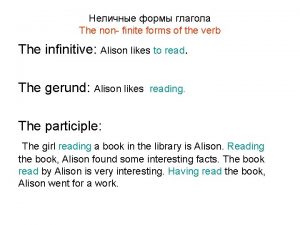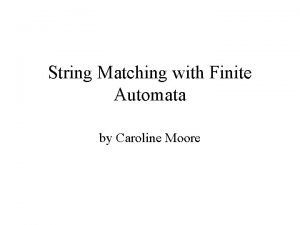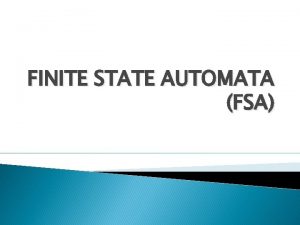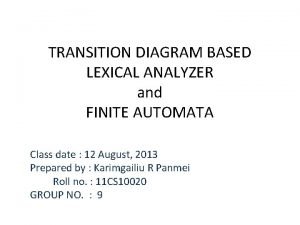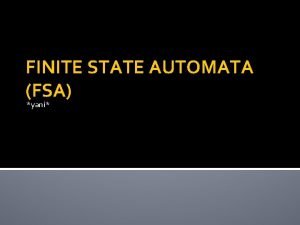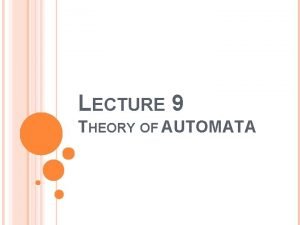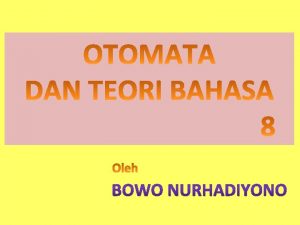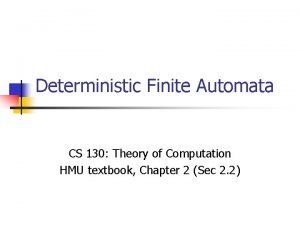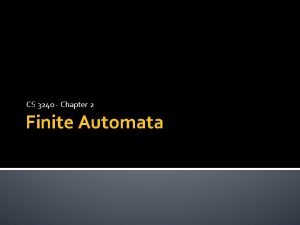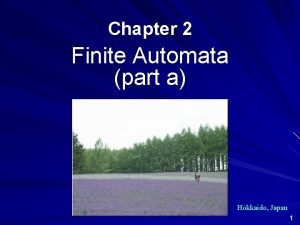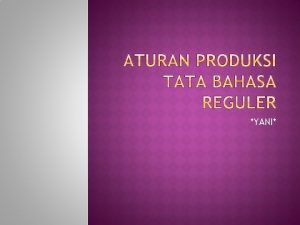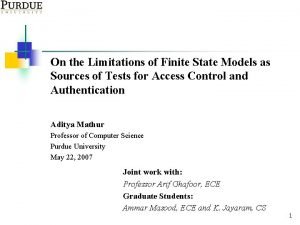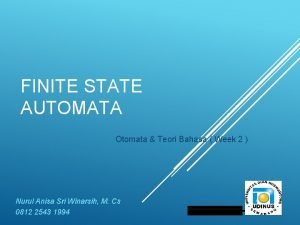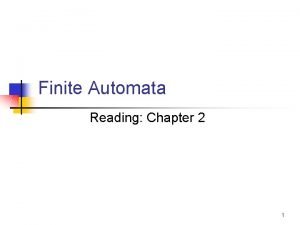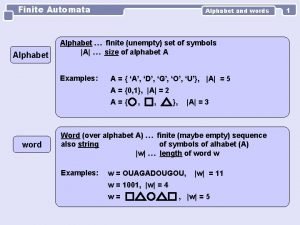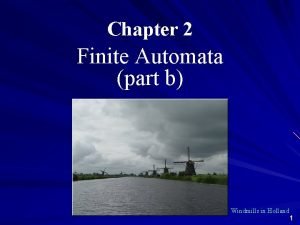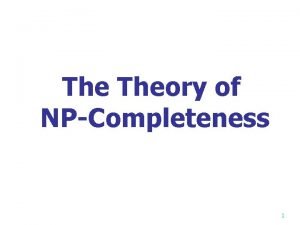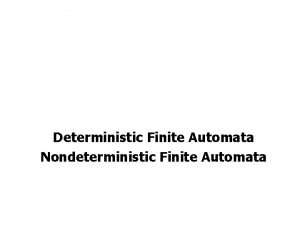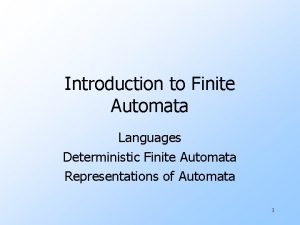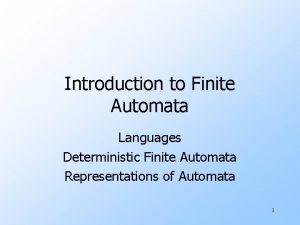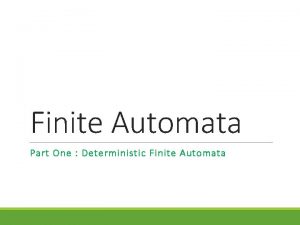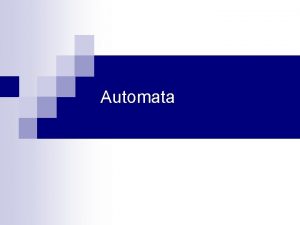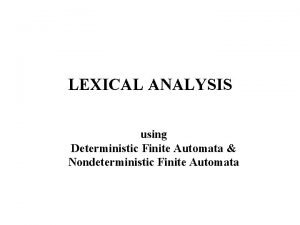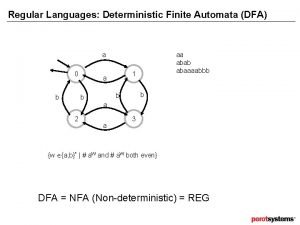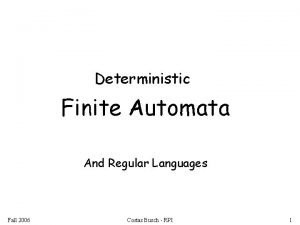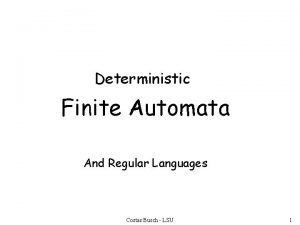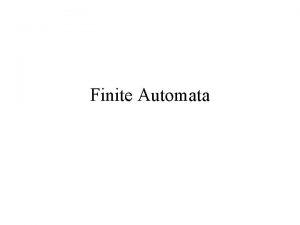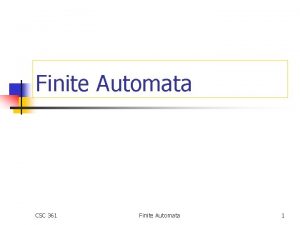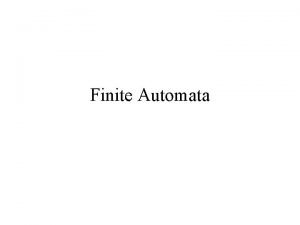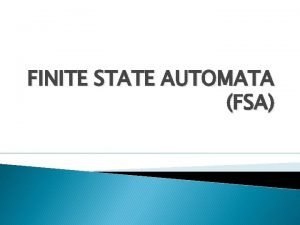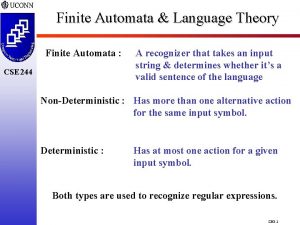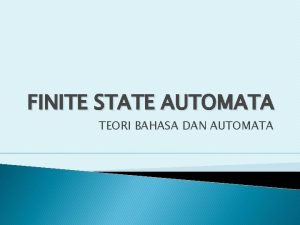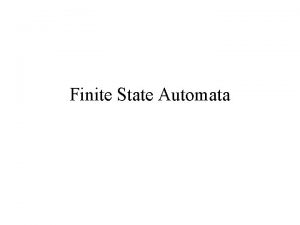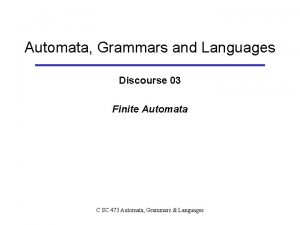Introduction to Finite Automata Languages Deterministic Finite Automata





































- Slides: 37

Introduction to Finite Automata Languages Deterministic Finite Automata Representations of Automata 1

Alphabets u. An alphabet is any finite set of symbols. u. Examples: ASCII, Unicode, {0, 1} (binary alphabet ), {a, b, c}. 2

Strings u. The set of strings over an alphabet Σ is the set of lists, each element of which is a member of Σ. w Strings shown with no commas, e. g. , abc. uΣ* denotes this set of strings. uε stands for the empty string (string of length 0). 3

Example: Strings u{0, 1}* = {ε, 0, 1, 00, 01, 10, 11, 000, 001, . . . } u. Subtlety: 0 as a string, 0 as a symbol look the same. w Context determines the type. 4

Languages u. A language is a subset of Σ* for some alphabet Σ. u. Example: The set of strings of 0’s and 1’s with no two consecutive 1’s. u. L = {ε, 0, 1, 00, 01, 10, 001, 010, 101, 0000, 0001, 0010, 0101, 1000, 1001, 1010, . . . } Hmm… 1 of length 0, 2 of length 1, 3, of length 2, 5 of length 3, 8 of length 4. I wonder how many of length 5? 5

Deterministic Finite Automata u A formalism for defining languages, consisting of: 1. A finite set of states (Q, typically). 2. An input alphabet (Σ, typically). 3. A transition function (δ, typically). 4. A start state (q 0, in Q, typically). 5. A set of final states (F ⊆ Q, typically). u “Final” and “accepting” are synonyms. 6

The Transition Function u. Takes two arguments: a state and an input symbol. uδ(q, a) = the state that the DFA goes to when it is in state q and input a is received. 7

Graph Representation of DFA’s u. Nodes = states. u. Arcs represent transition function. w Arc from state p to state q labeled by all those input symbols that have transitions from p to q. u. Arrow labeled “Start” to the start state. u. Final states indicated by double circles. 8

Example: Graph of a DFA Accepts all strings without two consecutive 1’s. 0 A 0, 1 1 Start Previous string OK, does not end in 1. B 1 C 0 Previous String OK, ends in a single 1. Consecutive 1’s have been seen. 9

Alternative Representation: Transition Table Final states starred Arrow for start state * A * B C 0 1 A A C B C C Columns = input symbols Rows = states 10

Extended Transition Function u. We describe the effect of a string of inputs on a DFA by extending δ to a state and a string. u. Induction on length of string. u. Basis: δ(q, ε) = q u. Induction: δ(q, wa) = δ(δ(q, w), a) w w is a string; a is an input symbol. 11

Extended δ: Intuition u. Convention: w … w, x, y, x are strings. w a, b, c, … are single symbols. u. Extended δ is computed for state q and inputs a 1 a 2…an by following a path in the transition graph, starting at q and selecting the arcs with labels a 1, a 2, …, an in turn. 12

Example: Extended Delta A B C 0 1 A A C B C C δ(B, 011) = δ(δ(B, 01), 1) = δ(δ(δ(B, 0), 1) = δ(δ(A, 1) = δ(B, 1) = C 13

Delta-hat u. In book, the extended δ has a “hat” to distinguish it from δ itself. u. Not needed, because both agree when the string is a single symbol. ˄ ˄ uδ(q, a) = δ(δ(q, ε), a) = δ(q, a) Extended deltas 14

Language of a DFA u. Automata of all kinds define languages. u. If A is an automaton, L(A) is its language. u. For a DFA A, L(A) is the set of strings labeling paths from the start state to a final state. u. Formally: L(A) = the set of strings w such that δ(q 0, w) is in F, the set of final states. 15

Example: String in a Language String 101 is in the language of the DFA below. Start at A. 0 A Start 0, 1 1 B 1 C 0 16

Example: String in a Language String 101 is in the language of the DFA below. Follow arc labeled 1. 0 A Start 0, 1 1 B 1 C 0 17

Example: String in a Language String 101 is in the language of the DFA below. Then arc labeled 0 from current state B. 0 0, 1 A Start 1 B 1 C 0 18

Example: String in a Language String 101 is in the language of the DFA below. Finally arc labeled 1 from current state A. Result is an accepting state, so 101 is in the language. 0 0, 1 A Start 1 B 1 C 0 19

Example – Concluded u. The language of our example DFA is: {w | w is in {0, 1}* and w does not have two consecutive 1’s} Such that… These conditions about w are true. Read a set former as “The set of strings w… 20

Proofs of Set Equivalence u. Often, we need to prove that two descriptions of sets are in fact the same set. u. Here, one set is “the language of this DFA, ” and the other is “the set of strings of 0’s and 1’s with no consecutive 1’s. ” 21

Proofs – (2) u In general, to prove S=T, we need to prove two parts: S ⊆ T and T ⊆ S. That is: 1. If w is in S, then w is in T. 2. If w is in T, then w is in S. u As an example, let S = the language of our running DFA, and T = “no consecutive 1’s. ” 22

Part 1: S ⊆ T 0 A 1 B 1 C u. To prove: if w is accepted by Start 0 then w has no consecutive 1’s. u. Proof is an induction on length of w. u. Important trick: Expand the inductive hypothesis to be more detailed than you need. 23 0, 1

The Inductive Hypothesis 1. If δ(A, w) = A, then w has no consecutive 1’s and does not end in 1. 2. If δ(A, w) = B, then w has no consecutive 1’s and ends in a single 1. u Basis: |w| = 0; i. e. , w = ε. w (1) holds since ε has no 1’s at all. w (2) holds vacuously, since δ(A, ε) is not B. “length of” Important concept: If the “if” part of “if. . then” is false, 24 the statement is true.

Inductive Step 0 A 1 B 1 C 0, 1 Start 0 u. Assume (1) and (2) are true for strings shorter than w, where |w| is at least 1. u. Because w is not empty, we can write w = xa, where a is the last symbol of w, and x is the string that precedes. u. IH is true for x. 25

Inductive Step – (2) 0 A 1 B 1 C 0, 1 Start 0 u. Need to prove (1) and (2) for w = xa. u(1) for w is: If δ(A, w) = A, then w has no consecutive 1’s and does not end in 1. u. Since δ(A, w) = A, δ(A, x) must be A or B, and a must be 0 (look at the DFA). u. By the IH, x has no 11’s. u. Thus, w has no 11’s and does not end in 1. 26

Inductive Step – (3) 0 A 1 B 1 C 0, 1 Start 0 u. Now, prove (2) for w = xa: If δ(A, w) = B, then w has no 11’s and ends in 1. u. Since δ(A, w) = B, δ(A, x) must be A, and a must be 1 (look at the DFA). u. By the IH, x has no 11’s and does not end in 1. u. Thus, w has no 11’s and ends in 1. 27

Part 2: T ⊆ S X u. Now, we must prove: if w has no 11’s, then w is accepted by 0 0, 1 A 1 B 1 C Y Start 0 u. Contrapositive : If w is not accepted by 0 A 1 B 1 C Start 0 0, 1 then w has 11. Key idea: contrapositive of “if X then Y” is the equivalent statement “if not Y then not X. ” 28

Using the Contrapositive 0 A 1 B 1 C 0, 1 Start 0 u. Every w gets the DFA to exactly one state. w Simple inductive proof based on: • Every state has exactly one transition on 1, one transition on 0. u. The only way w is not accepted is if it gets to C. 29

Using the Contrapositive – (2) 0 A 1 B 1 C 0, 1 Start 0 u. The only way to get to C [formally: δ(A, w) = C] is if w = x 1 y, x gets to B, and y is the tail of w that follows what gets to C for the first time. u. If δ(A, x) = B then surely x = z 1 for some z. u. Thus, w = z 11 y and has 11. 30

Regular Languages u. A language L is regular if it is the language accepted by some DFA. w Note: the DFA must accept only the strings in L, no others. u. Some languages are not regular. w Intuitively, regular languages “cannot count” to arbitrarily high integers. 31

Example: A Nonregular Language L 1 = {0 n 1 n | n ≥ 1} u. Note: ai is conventional for i a’s. w Thus, 04 = 0000, e. g. u. Read: “The set of strings consisting of n 0’s followed by n 1’s, such that n is at least 1. u. Thus, L 1 = {01, 0011, 000111, …} 32

Another Example L 2 = {w | w in {(, )}* and w is balanced } w Note: alphabet consists of the parenthesis symbols ’(’ and ’)’. w Balanced parens are those that can appear in an arithmetic expression. • E. g. : (), ()(), (()()), … 33

But Many Languages are Regular u. Regular Languages can be described in many ways, e. g. , regular expressions. u. They appear in many contexts and have many useful properties. u. Example: the strings that represent floating point numbers in your favorite language is a regular language. 34

Example: A Regular Language L 3 = { w | w in {0, 1}* and w, viewed as a binary integer is divisible by 23} u. The DFA: w 23 states, named 0, 1, …, 22. w Correspond to the 23 remainders of an integer divided by 23. w Start and only final state is 0. 35

Transitions of the DFA for L 3 u. If string w represents integer i, then assume δ(0, w) = i%23. u. Then w 0 represents integer 2 i, so we want δ(i%23, 0) = (2 i)%23. u. Similarly: w 1 represents 2 i+1, so we want δ(i%23, 1) = (2 i+1)%23. u. Example: δ(15, 0) = 30%23 = 7; δ(11, 1) = 23%23 = 0. Key idea: design a DFA by figuring out what each state needs to remember about the 36 past.

Another Example L 4 = { w | w in {0, 1}* and w, viewed as the reverse of a binary integer is divisible by 23} u. Example: 01110100 is in L 4, because its reverse, 00101110 is 46 in binary. u. Hard to construct the DFA. u. But theorem says the reverse of a regular language is also regular. 37
 Nfa non deterministic finite automata
Nfa non deterministic finite automata Deterministic finite state automata
Deterministic finite state automata Deterministic finite automaton
Deterministic finite automaton Nondeterministic means choice of moves for automata *
Nondeterministic means choice of moves for automata * Moore machine
Moore machine Dfa ndfa
Dfa ndfa Csci 3130
Csci 3130 Automata theory tutorial
Automata theory tutorial Cyk algorithm
Cyk algorithm Csci 3130
Csci 3130 Csci3130
Csci3130 Fused relative clause
Fused relative clause Finite verb
Finite verb Learning objectives of non finite verbs
Learning objectives of non finite verbs Finite and non finite clause
Finite and non finite clause Finite and non finite
Finite and non finite Contoh soal dan jawaban teori bahasa dan automata
Contoh soal dan jawaban teori bahasa dan automata String matching finite automata
String matching finite automata Finite automata dikelompokkan menjadi
Finite automata dikelompokkan menjadi Lexical analysis finite automata
Lexical analysis finite automata Transition graph in automata
Transition graph in automata Diagram fsa
Diagram fsa Finite automata tutorial
Finite automata tutorial Kleenes theorem
Kleenes theorem Output berasosiasi dengan state adalah untuk
Output berasosiasi dengan state adalah untuk Finite automata calculator
Finite automata calculator Finite automata
Finite automata An informal picture of finite automata
An informal picture of finite automata Aturan produksi
Aturan produksi Limitations of finite state machine
Limitations of finite state machine Finite automata
Finite automata Gambarlah diagram transisi untuk nfa berikut
Gambarlah diagram transisi untuk nfa berikut Finite automata
Finite automata Alphabet in finite automata
Alphabet in finite automata Finite automata with epsilon transitions
Finite automata with epsilon transitions Introduction to scripting languages
Introduction to scripting languages Introduction to programming languages
Introduction to programming languages Spanning tree of a graph
Spanning tree of a graph
